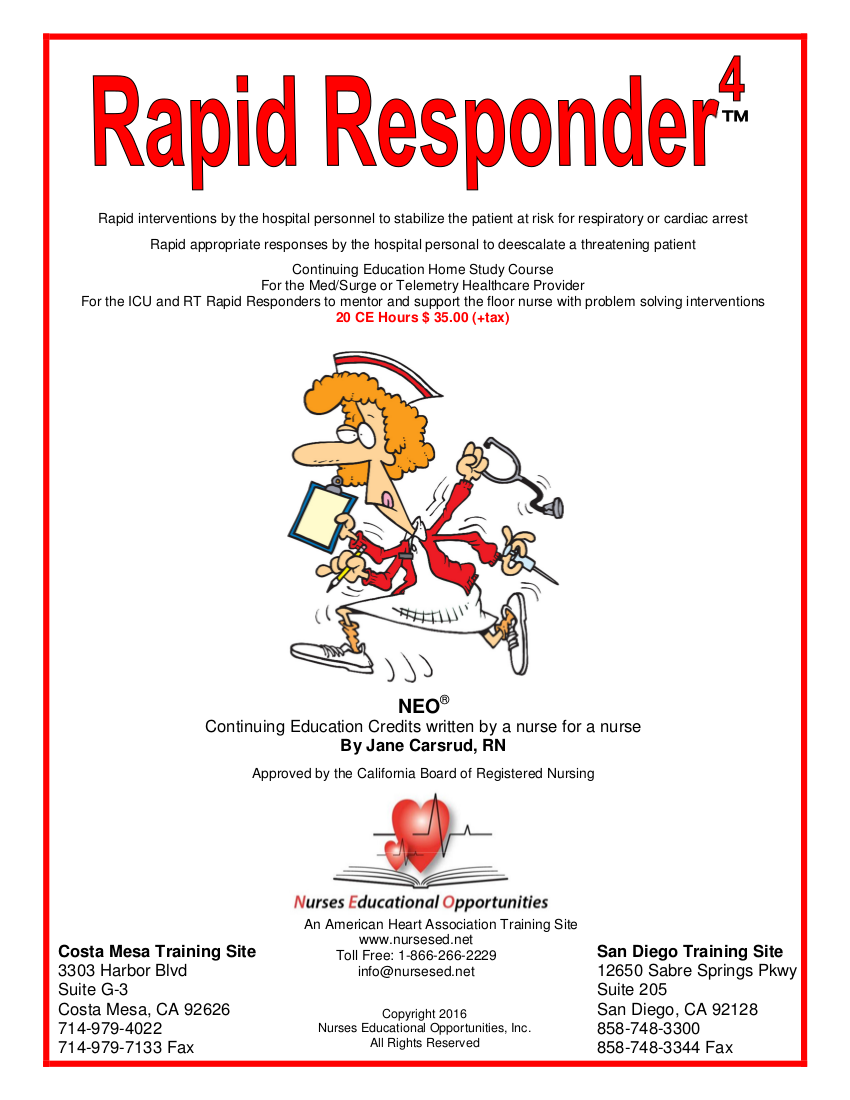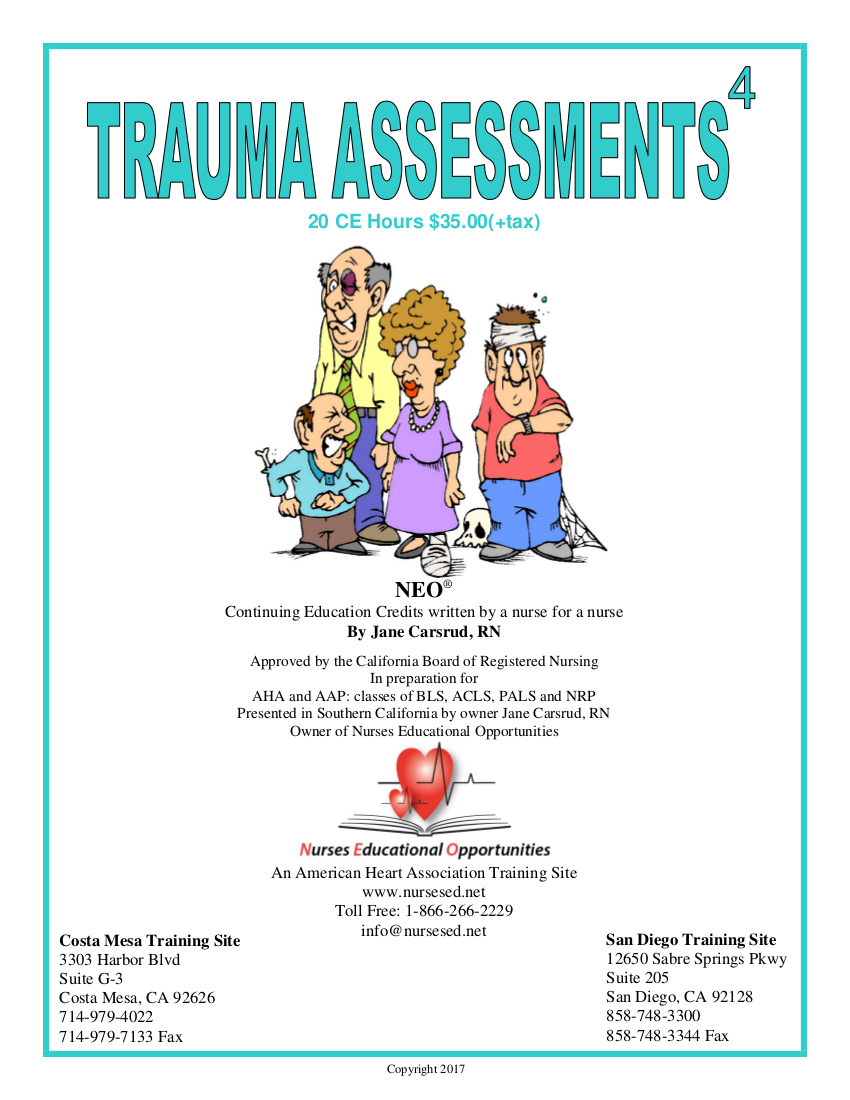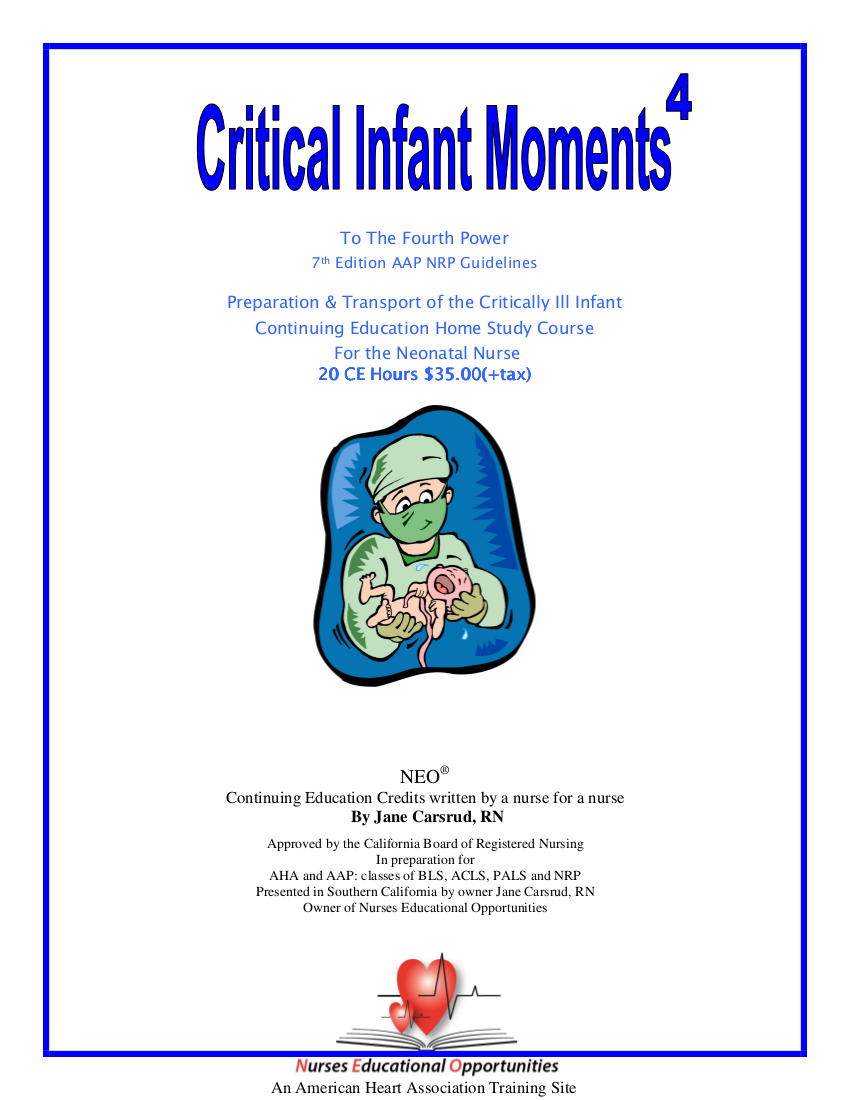
Rapid Responder to the 4th Power
Price: $38
CEs: 20 CEs
Provider approved by the California Board of Registered Nursing, Provider Number 13004 for 20 contact hours.
Rapid interventions by the hospital personnel to stabilize the patient at risk for respiratory or cardiac arrest
Rapid appropriate responses by the hospital personal to deescalate a threatening patient.
Recommended for:
For the Nurse in ER and ICU.
For the Med/Surg or Telemetry Healthcare Provider
For the ICU and RT Rapid Responders to mentor and support the floor nurse with problem solving interventions.
Upon conclusion of Chapter One, The Patient with Respiratory Distress, the student will be able to:
- State the assessment criteria of a patient with respiratory distress by evaluating pulse oximetry and adjusting oxygen flow rate with appropriate airway adjuncts.
- State the significance of a patient’s adventitious lung sounds and increase or decrease respiratory rate.
- State 8 interventions to proceed with prior to notifying the Rapid Response Team.
Upon conclusion of Chapter Two, The Patient with an Anaphylaxis, the student will be able to state:
- Eight signs and symptoms of an anaphylactic reaction
- Four interventions to intercede the anaphylactic reaction
- Three measures to prevent an anaphylactic reaction
Upon completion of Chapter Three, The Patient with Bradycardia, the student will be able to:
- State two criteria for determining if the patient’s bradycardia is symptomatic.
- State 6 symptoms of symptomatic bradycardia.
- State 6 signs of symptomatic bradycardia.
- State 4 interventions of symptomatic bradycardia.
- State 8 interventions to proceed with prior to notifying the Rapid Response Team.
Upon completion of Chapter Four, The Patient with Tachycardia, the student will be able to state the following:
- The difference between a sinus tachycardia and supraventricular tachycardia
- The difference between a narrow-complex tachycardia and a wide-complex tachycardia.
- The difference between a monomorphic tachycardia and a polymorphic tachycardia.
- The difference between defibrillation and cardioversion.
- The guidelines for administering Adenosione
Upon completion of Chapter Five, The Patient with Suspected Stroke, the student will be able to:
- State three conditions that can mimic a stroke.
- Discuss the characteristics of a TIA.
- Name the significant signs and symptoms of an acute ischemic or hemorrhagic stroke.
- Name the subtle signs and symptoms of an acute ischemic or hemorrhagic stroke.
- Discuss the essential guidelines of anyone expected of having an acute ischemic or hemorrhagic stroke.
- Discuss the interventions that must be done immediately if you suspect an acute ischemic or hemorrhagic stroke.
Upon the conclusion of Chapter Six, The Patient with Chest Pain, the student will be able to state:
- Six signs and symptoms of someone experiencing a myocardial infarction
- Four alternatives diagnostic possibilities of someone experiencing a myocardial infarction
- Six interventions to be completed of someone experiencing a myocardial infarction
- Two treatments for STEMI
Upon completion of Chapter Seven, The Unresponsive Patient, the student will be able to verbalize:
- The responsibilities of the First Responder
- The responsibilities of the Second Responder
- The responsibilities of the Documentation Nurse
- The responsibilities of the Defibrillation Nurse
- The responsibilities of the Charge Nurse
- The responsibilities of the Intubationist
Upon completion of Chapter Eight, Family Presence During a Code, the student will be able to:
- Name the national organizations that support family presence during a code.
- Identify the common concerns of nurses about family presence during a code.
- Discuss the legal implications of family presence during a code.
Upon the completion of Chapter Nine, The Patient that Threatens You, the student will be able to:
- Discuss the “Fight or Flight” response during an assaultive incident.
- Name the five phases of the cyclical pattern of a persons assaulting in response to stress.
- Discuss violence from the perspective of human development.
- Name five patterns of communication that empowers us to determine early signs and signals of assault.
- Discuss the difference between simple assault, assault and battery, and aggravated assault.
- Define reasonable force.
- Describe five principles of crisis communication.
- Name four reasons why people threaten.
- Name the visual signs of fear and the visual signs of frustration.
- Name the auditory signs of fear and the auditory signs of frustration.
- Name the principles of responding to a person that is threatening.
- Name the principles of responding to a person that in manipulating.
- Name the principles of responding to a person that is intimidating.
- Name the principles of evasion as a means of avoiding assault and battery.
- Name three ways to restrain an out-of-control client.
- Name the principles for applying mechanical restraints.
- Name the principles for caring for a client with mechanical restraints.
- Name the principles for recording an event a client that is threatening.


